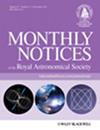Persistent gravitational radiation from glitching pulsars. II. Updated scaling with vortex number
IF 4.8
3区 物理与天体物理
Q1 ASTRONOMY & ASTROPHYSICS
引用次数: 0
Abstract
Superfluid vortices pinned to nuclear lattice sites or magnetic flux tubes in a neutron star evolve abruptly through a sequence of metastable spatial configurations, punctuated by unpinning avalanches associated with rotational glitches, as the stellar crust spins down electromagnetically. The metastable configurations are approximately but not exactly axisymmetric, causing the emission of persistent, quasimonochromatic, current quadrupole gravitational radiation. The characteristic gravitational wave strain h0 as a function of the spin frequency f and distance D from the Earth is bounded above by $h_0 = 1.2\substack{+1.3 \\-0.9} \times 10^{-32} (f/30\,\,{\rm Hz})^{2.5} (D/1\,\,{\rm kpc})^{-1}$, corresponding to a Poissonian spatial configuration (equal probability per unit area, i.e. zero inter-vortex repulsion), and bounded below by $h_0 = 1.8\substack{+2.0 \\-1.5} \times 10^{-50} (f/30\,\,{\rm Hz})^{1.5} (D/1\,\,{\rm kpc})^{-1}$, corresponding to a regular array (periodic separation, i.e. maximum inter-vortex repulsion). N-body point vortex simulations predict an intermediate scaling, $h_0 = 7.3\substack{+7.9 \\-5.4} \times 10^{-42} (f/30\,\,{\rm Hz})^{1.9} (D/1\,\,{\rm kpc})^{-1}$, which reflects a balance between the randomizing but spatially correlated action of superfluid vortex avalanches and the regularizing action of inter-vortex repulsion. The scaling is calibrated by conducting simulations with Nv ≤ 5 × 103 vortices and extrapolated to the astrophysical regime Nv ∼ 1017(f/30 Hz). The scaling is provisional, pending future computational advances to raise Nv and include three-dimensional effects such as vortex tension and turbulence.来自闪烁脉冲星的持续引力辐射。II.涡旋数的更新缩放
当恒星外壳电磁自旋下降时,钉在中子星核晶格位置或磁通量管上的超流体涡旋会突然通过一连串的可变空间构型发生演变,其间会出现与旋转闪烁相关的解钉雪崩。这些瞬变构型近似于轴对称,但并不完全是轴对称的,因此会产生持续的、准双色的、电流四极引力辐射。特征引力波应变 h0 是自旋频率 f 和与地球距离 D 的函数,其边界为 $h_0 = 1.2\substack{+1.3\-0.9}\times 10^{-32} (f/30\,{\rm Hz})^{2.5}(D/1\,{\rm kpc})^{-1}$, 对应于泊松空间构型(单位面积上的概率相等,即涡旋间的排斥力为零),下面的边界为 $h_0 = 1.8\substack{+2.0\-1.5}.\times 10^{-50} (f/30\,{\rm Hz})^{1.5}(D/1\,{\rm kpc})^{-1}$,对应于规则阵列(周期性分离,即涡旋间斥力最大)。N-体点涡模拟预测了一个中间缩放,$h_0 = 7.3\substack{+7.9\-5.4}.\乘以 10^{-42}(f/30\,{\rm Hz})^{1.9} (D/1\,{\rm kpc})^{-1}$,这反映了超流体涡旋雪崩的随机但空间相关的作用与涡旋间排斥的正则作用之间的平衡。通过对 Nv ≤ 5 × 103 个涡旋进行模拟,并推断出天体物理机制 Nv ∼ 1017(f/30 Hz),校准了缩放比例。该缩放是临时的,有待于未来计算的进步,以提高 Nv 并包括三维效应,如涡旋张力和湍流。
本文章由计算机程序翻译,如有差异,请以英文原文为准。
求助全文
约1分钟内获得全文
求助全文
来源期刊

Monthly Notices of the Royal Astronomical Society
ASTRONOMY & ASTROPHYSICS-
CiteScore
9.10
自引率
37.50%
发文量
3198
审稿时长
3 months
期刊介绍:
Monthly Notices of the Royal Astronomical Society is one of the world''s leading primary research journals in astronomy and astrophysics, as well as one of the longest established. It publishes the results of original research in positional and dynamical astronomy, astrophysics, radio astronomy, cosmology, space research and the design of astronomical instruments.
 求助内容:
求助内容: 应助结果提醒方式:
应助结果提醒方式:


